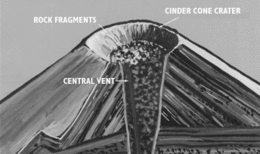
Back مخروط رماد Arabic Шлаков конус Bulgarian সিন্ডার কোণ Bengali/Bangla Con d'escòria Catalan Sypaný kužel Czech Schlackenkegel German Cono de escoria Spanish Šlakikoonus Estonian Zepa-kono Basque مخروط اخگری Persian

A cinder cone (or scoria cone[1]) is a steep conical hill of loose pyroclastic fragments, such as volcanic clinkers, volcanic ash, or scoria that has been built around a volcanic vent.[2][3] The pyroclastic fragments are formed by explosive eruptions or lava fountains from a single, typically cylindrical, vent. As the gas-charged lava is blown violently into the air, it breaks into small fragments that solidify and fall as either cinders, clinkers, or scoria around the vent to form a cone that often is symmetrical; with slopes between 30 and 40°; and a nearly circular ground plan.[4] Most cinder cones have a bowl-shaped crater at the summit.[2]
- ^ Allaby, Michael (2013). "cinder cone". A dictionary of geology and earth sciences (Fourth ed.). Oxford: Oxford University Press. ISBN 9780199653065.
- ^ a b Poldervaart, A (1971). "Volcanicity and forms of extrusive bodies". In Green, J; Short, NM (eds.). Volcanic Landforms and Surface Features: A Photographic Atlas and Glossary. New York: Springer-Verlag. pp. 1–18. ISBN 978-3-642-65152-6.
- ^
 This article incorporates public domain material from Photo glossary of volcano terms: Cinder cone. United States Geological Survey.
This article incorporates public domain material from Photo glossary of volcano terms: Cinder cone. United States Geological Survey.
- ^ Clarke, Hilary; Troll, Valentin R.; Carracedo, Juan Carlos (2009-03-10). "Phreatomagmatic to Strombolian eruptive activity of basaltic cinder cones: Montaña Los Erales, Tenerife, Canary Islands". Journal of Volcanology and Geothermal Research. Models and products of mafic explosive activity. 180 (2): 225–245. Bibcode:2009JVGR..180..225C. doi:10.1016/j.jvolgeores.2008.11.014. ISSN 0377-0273.
© MMXXIII Rich X Search. We shall prevail. All rights reserved. Rich X Search